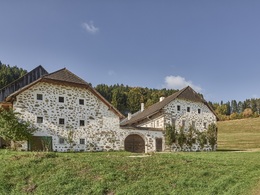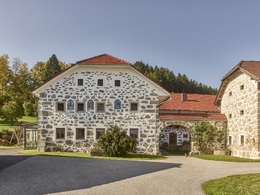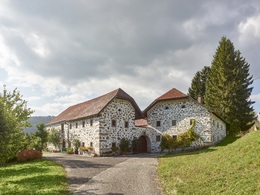Steinbloßhäuser im Mühlviertel
Hirschbach im Mühlkreis, Oberösterreich, Österreich
Museumsweg 7
4242 Hirschbach im Mühlkreis
4242 Hirschbach im Mühlkreis

Steinbloß - simply typical Mühlviertel
A journey in the footsteps of stone treasures
In the Mühlviertler Alm Freistadt holiday region there are many stone-bloß houses, the best known being Hirschbach with its stone-bloß wall trail. But Neumarkt and Lasberg are also known for their "spotted courtyards".
But what is the story behind these strangely spotted farms? The old stone-block facades of the farms nestle beautifully in the rolling Mühlviertel hills.Stone-block architecture in the Mühlviertel:
This beautiful form of masonry is referred to as stone-block construction because it was created by the natural conditions in the Mühlviertel. On the one hand, this is the great abundance of stones and, on the other, the lack of lime, which was needed to plaster the walls. As the lime had to be bought from the areas south of the Danube and transported uphill with great effort, they were content with plastering the spaces between the stones. This probably resulted in this unique construction method, which can be admired here.
The majority of these beautiful stone-built farmsteads in this form that can be seen today were built in the middle of the 19th century, mostly as a result of lightning or carelessness on the part of farmers or servants. But there was also an upswing after the end of the manorial estates in 1848/50. Many residential and commercial areas were rebuilt using stone, clay and sand from the stream (brook sand), and many farms changed hands through sale and purchase. Stones always needed two beautiful sides - the support and the visible side, in the case of corner stones even three sides including the head side.
Courtyards - types of courtyard in the Mühlviertel
Two-sided courtyard, three-sided courtyard and square courtyard, whereby the three-sided courtyard is the majority in our region. The "Dreiseiteinspringer" is a special form, but is less common. The Vierkanter is already present in our area, but is more common in the southern district and especially towards the Danube - in the district of Perg. The wall thicknesses: various wall thicknesses approx. 80-90/100 cm ground floor, upper floor 60-70/80 cm (in my parents' house from 1873, for example, 78 cm at the bottom, 60 cm at the top.
The Steinbloß-Mauer-Weg is 12.5 km long and shows above all the versatile use of "Mühlviertel granite". The typical "Steinbloßhof" here on the hiking trail is the centre of the "Steinbloßbauweise" in the Mühlviertel with Hirschbach, Lasberg, Ottenschlag and the village of Stiftung near Neumarkt im Mühlkreis. This unique building style here in the Mühlviertel should have earned its place on the World Heritage List.
4242 Hirschbach im Mühlkreis
Phone +43 7948 541
E-Mail freistadt@muehlviertel.at
Web www.muehlviertel.at/magazin/steinbl…
Web www.4242.at/museum/
https://www.muehlviertel.at/magazin/steinbloss.html
https://www.4242.at/museum/
https://www.4242.at/museum/
Contact person
Tourismusverband Mühlviertel
Lebensquellplatz 1
4283 Bad Zell
Phone +43 5 07263 - 301
E-Mail badzell@muehlviertel.at
Web www.muehlviertel.at
- always open (24/7)
- by arrangement
- Can only be viewed from outside
- Free entry
- All weather
- Suitable for seniors
- Suitable for single travelers
- Suitable for friends
- Suitable for couples
Season
- Spring
- Summer
- Autumn
- Winter
Please get in touch for more information.




